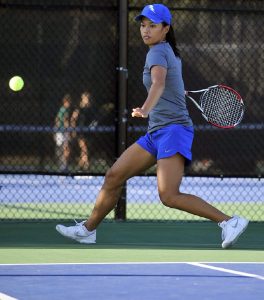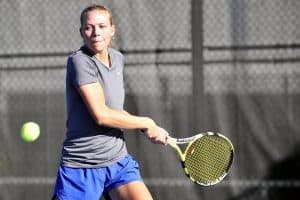
How to Become a Better Tennis Counterpuncher
The counterpunch style of tennis, one of four major styles of tennis, is made up of a tireless player willing to hit shot after shot, no matter how long it takes. The style itself is one designed to outlast the opponent. It’s purpose is to force the opponent to make the mistake. A successful counterpuncher is adept at forcing unforced errors. Sheer probability suggests the more shots you take, the more likely you are to make a mistake.
A counterpuncher will take safer shots, giving them a higher probability of fewer unforced errors, but also a lower number of winners. To get a winner you must take a few chances. The goal is to force the opponent to take chances that are out of their own comfort zone. Continuing to hit the ball back and essentially becoming a “backboard” to the opponent can frustrate them into making an error they wouldn’t normally make.
More often than not, the error an opponent will make will not just be a shot they hit out or in the net, but could be a shot one, two, or more shots before that set them up to miss their shot. For instance, after 3 or 4 shots the opponent might hit a ball just a few feet shorter than normal, which doesn’t seem like much except it gives you the opportunity to hit an approach shot. This well positioned approach shot, which doesn’t have to be a winner, could be enough for the opponent to hit his shot out or into the net. It’s the successful shots on shot 3 or 5 that will set you up to win the point on shots 5 and 6.

Do I Need a Great Serve?
A great serve is not necessary in this style, but, as always, is extremely helpful if you have one. The ability to gain significant control of a point will certainly help shorten your points and give you the energy to maintain the counterpunch style throughout the rest of the match.
However, a player with a great serve doesn’t typically use the counterpunch style, as reverting to that style after a successful serve only ‘serves’ to limit the control the server has in that particular point. A great serve peaks your point advantage immediately, and losing that on purpose seems to be counterproductive.
Instead, a well placed serve, using a principal that a fair first serve is almost always more effective than a good second serve, will allow the control of the point to begin with the counterpuncher. Your attack and gameplan can begin right away.

The Counterpuncher Gameplan
The gameplan for a counterpuncher is to be able to hit more balls back than the opponent can. This means fitness is a key asset, or detriment, to this style. The first thing you must be is more fit than the other player. You must be able to withstand long stretches where you are hunting the ball down, running side to side, retrieving and hitting it back to the other side with a safe shot. You are an overactive baseliner.
Footwork and positioning are key, as always, to this style. Be in position to get to the ball that is inevitably coming, and do this by using great, purposeful footwork. Don’t cross your feet, stay on your toes, and don’t guess at the shot coming. You’ll know it when you know it.
Limit your attempts at winners. The more chances you take, the more your chances of winning go down. There will be opportunities to put the point away. Take advantage when you can, as long as you keep the shots safe and precise.
Aim 2-3 feet inside the court boundaries. This will give you a little bit of tolerance if you don’t hit your target. You may even want to start 4 feet or more depending on your skill level, and shrink that number over time.
Preparing With the Plan
Because fitness is the one thing that can take you from an effective counterpuncher to one who wins with this style, exercise, eating right, and of course hydration are essential. Each person will have their own regiment for working out and a healthy diet, and should follow it to maximize this style of play.
Needless to say, this is not my style of play. My fitness level would never allow it!
Footwork can and should always be worked on. Concentrate on retreating back to the middle of the court 2-3 feet behind the baseline after each shot. Make sure you NEVER cross your feet. There will be times in a match you may not have a choice but to cross your feet, and that’s fine, but practice as if you are NOT ALLOWED that way the habit of not crossing your feet will be in place for every movement that you don’t require crossing your feet.
Speed is not just a benefit of fitness, but of great footwork, so ensure this is practiced every time you drill.
Control your attempts at winners. Place a target on the baseline and 1-2 feet from the center line. This target is where your opponent might stand. Place another target on the other side of the center line about 2-3 feet inside the baseline and 2-3 feet from the doubles alley. This is your target. DO NOT go outside of this target. Even if it falls 1 foot inside the baseline and doubles alley, this should be counted as “out” in practice. This will allow you to gain the habit of putting the ball in a safe but effective area that is inside the boundaries but still forces the opponent to move to the other side of the court to hit the ball.
Moving your opponent is important to forcing mistakes, so get used to hitting to the left and then to the right side of the court, back and forth like a pendulum. Working with a variety of angles will get you in the proper mindset, so move the ball a bit left and right and up and down from different positions on the court, always trying to retreat to the middle behind the baseline.

Don’t Get Caught In No Man’s Land
No man’s land is the space between the service line and the baseline. A good tennis counterpuncher does NOT get caught in no man’s land. While your instinct should be to move back to behind the baseline and to the center of the court, when a good approach shot opportunity comes your way, take advantage and move to the net. Practicing your net play and volleys are important, as it should be a part of everyone’s game.
To beat a counterpuncher, attempt to move them up to the net. A counterpuncher is adept at moving side to side, so bring them to the net and attempt to shorten the point.
Shortening the point will mitigate the general advantage the counterpuncher carries in fitness. Superior footwork will help put you in position to make the shots you need to beat a counterpuncher.
Limit your own mistakes to beat a counter punch style tennis player. The goal they carry is to force your mistakes into existence, so you should respond by not making them. Be more aware of your winner opportunities, as you will need a good ratio of winners vs unforced errors to beat the counterpuncher.
The System is Sound
The counterpunch style will keep you in points, but not often win you the tough ones. You will be a difficult out, and can win surprise victories against superior opponents if you can manage to rattle their cage, which this style most effectively does.
Good luck and get out there safely when you can!

